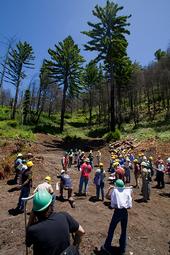- Author: Shelly Leachman
Reposted from the University of California newsroom
Just how far apart are Republicans and Democrats when it comes to views on climate change? Not all that far, as it turns out. They're just too party-focused to notice.
Credit: Sarah Anderson
That's according to scientists from UC Santa Barbara and the University of Colorado Boulder in new research just...
- Author: Kat Kerlin
Reposted from UC Davis News
With nearly 9 million acres burned this year across the nation, 2015 is shaping up to be one of the most destructive wildfire seasons yet in a decade strung with devastating fire seasons. And with drought and climate change, wildfires are only predicted to get worse.
At a time when forest fires are predicted to grow throughout the West, national forest managers, policymakers and the public currently have unique opportunities to reform wildfire management. (U.S. Army/photo)
In a commentary published...
- Author: Richard B. Standiford
- Author: Jaime Adler

Introduction
The Coast Redwood Forests in a Changing California Science Symposium was held June 21-23, 2011 at UC Santa Cruz with just under 300 registrants in attendance. Participants ranged in background from graduate level students to university forestry faculty, land managers, and conservation groups, public agencies, and land trust members. The symposium was strategically held in Santa Cruz, near the Southern end of the redwood region. Designed to present the state of our knowledge about California’s coast redwood forest ecosystems and sustainable management practices, this symposium was built on earlier redwood science symposia held in Arcata, CA in June, 1996 and in Santa Rosa, CA in March, 2004.
- Author: Jaime Adler
June 21-23, 2011
University of California, Santa Cruz
Policies and strategies guiding the use and management of California’s coastal ecoregion are dependent on objective scientific information. Attention to this region has increased in recent years. At the same time, much new information has been collected. Each year the array of decisions affecting lands and natural resources in the redwood region carry more weight; evidence the recent interest in watershed assessment, fish and wildlife recovery efforts and silvicultural changes. This symposium is part of a continuing effort to...


